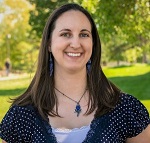Jun 25
2020
Careers In Healthcare Are A Sound Investment

Now more than ever, society needs skilled healthcare workers. The current shortage of medical professionals is an opportunity for the students of today to become the healthcare heroes of tomorrow. And while college is admittedly expensive, an investment in a healthcare education will pay a handsome return in the years to come, according to Dr. Johnica J. Morrow, Pre-Health Pathways advisor at South Dakota School of Mines & Technology.
South Dakota Mines is working hard to prepare its pre-health students to enter health professions and address these needs in rural America and across the country, says Morrow. Pre-health students at Mines are pursing degrees in traditional fields such as biology, chemistry and pre-professional health sciences, as well as in engineering fields, such as mechanical, industrial and biomedical. These students have bright futures, in part because South Dakota Mines ranks as the best in the nation for return on investment.
The healthcare industry has a great job outlook, Morrow says. By the end of 2018, there were 16.2 million people working in the healthcare sector, accounting for about 11% of all jobs in the United States. It’s also one of the fastest growing industries in the country, with around 346,000 jobs created in 2018, which equates to about 29,000 new jobs every month. The Bureau of Labor Statistics expects that the industry will continue to grow, projecting a 14% increase between 2018 and 2028, which will add an additional 1.9 million over that decade.
In small rural states like South Dakota, the number of jobs in healthcare is projected to grow by 6.8% between 2016-2026, with an average of 58,885 annual job openings in the industry. Much of this anticipated growth stems from having a population that is getting older as the last of the baby boomers become senior citizens. As a population ages, and a generation with a large cohort of current healthcare workers enters retirement, there becomes a greater demand for healthcare providers.
Right now, there is a major shortfall in the number of healthcare professionals needed to address this growing need for health care services. The American Association of Medical Colleges (AAMC) estimates that there could be a shortage of more than 120,000 physicians through 2030. This shortage will have significant impacts on mortality rates and life expectancy.
A study in JAMA International Medicine from 2019 showed that counties with more family doctors had lower mortality rates than those with fewer physicians, and life expectancy was shown to increase by almost two months on average for every 10 additional primary care physicians per 100,000 people. And this is only looking at how shortages in physicians impact people’s lives. We also desperately need more nurses, physician’s assistants, medical lab scientists, occupational therapists, and many other people with training in the myriad of health professions.
At South Dakota Mines, pre-health students develop skills in critical thinking, time management, effective study techniques, leadership and teamwork while pursuing their degrees, Morrow says. Mines offers student support services such as the Center for Inclusion, the Career and Professional Development Center, the Student Leadership, Involvement and Community Engagement (SLICE) office and the Student Success Center. It’s dedicated staff members across campus are invested in helping students achieve their full potential.
“In my position at the Pre-Health Pathways office within the Student Success Center, I help students gain the competencies, identify and seize the opportunities, and find the resources that they need to be competitive candidates for getting into professional programs in healthcare,” Morrow says. “This unique office works with students from their first semester as a pre-health student to help them explore health career options, create a personal timeline, set professional development goals, connect to resources both on and off campus, prepare for entrance exams, navigate the application process, and do well on their interviews.”
The South Dakota Mines Pre-Health Pathways office has also recently launched Pre-Health Experiences in Volunteering, Education, Research, and Shadowing (or PHEVERS, pronounced “fevers”), a student-centered, co-curricular program to further help students learn about the healthcare industry and develop competencies that will make them both stronger candidates for professional programs and better healthcare workers once they complete their professional training.
PHEVERS students not only engage in activities within the four major areas (volunteering, education, research and shadowing), but are also required to reflect on their experiences, which helps them to think more deeply about the value of those experiences and how various activities are preparing them for careers in healthcare.
Between the academic rigor, the many opportunities for developing leadership skills by being involved in campus organizations and events, and the dedicated staff in various student services at South Dakota Mines, pre-health students have everything that they need to grow professionally and be prepared for a career in healthcare.